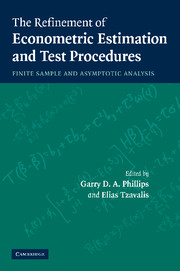Book contents
- Frontmatter
- Contents
- List of figures
- List of tables
- List of contributors
- Preface
- Acknowledgements
- Michael Magdalinos 1949–2002
- Introduction
- 1 Conditional Heteroskedasticity Models with Pearson Disturbances
- 2 The Instrumental Variables Method Revisited: On the Nature and Choice of Optimal Instruments
- 3 Nagar-Type Moment Approximations in Simultaneous Equation Models: Some Further Results
- 4 Local GEL Methods for Conditional Moment Restrictions
- 5 Limit Theory for Moderate Deviations From a Unit Root Under Weak Dependence
- 6 The Structure of Multiparameter Tests
- 7 Cornish-Fisher Size Corrected t and F Statistics for the Linear Regression Model with Heteroscedastic Errors
- 8 Non-Parametric Specification Testing of Non-Nested Econometric Models
- 9 Testing for Autocorrelation in Systems of Equations
- 10 Alternative Approaches to Estimation and Inference in Large Multifactor Panels: Small Sample Results with an Application to Modelling Asset Returns
- 11 Judging Contending Estimators by Simulation: Tournaments in Dynamic Panel Data Models
- 12 A Statistical Proof of the Transformation Theorem
- 13 On the Joint Density of the Sum and Sum of Squares of Non-Negative Random Variables
- 14 Conditional Response Analysis
- References
- Index
8 - Non-Parametric Specification Testing of Non-Nested Econometric Models
Published online by Cambridge University Press: 22 September 2009
- Frontmatter
- Contents
- List of figures
- List of tables
- List of contributors
- Preface
- Acknowledgements
- Michael Magdalinos 1949–2002
- Introduction
- 1 Conditional Heteroskedasticity Models with Pearson Disturbances
- 2 The Instrumental Variables Method Revisited: On the Nature and Choice of Optimal Instruments
- 3 Nagar-Type Moment Approximations in Simultaneous Equation Models: Some Further Results
- 4 Local GEL Methods for Conditional Moment Restrictions
- 5 Limit Theory for Moderate Deviations From a Unit Root Under Weak Dependence
- 6 The Structure of Multiparameter Tests
- 7 Cornish-Fisher Size Corrected t and F Statistics for the Linear Regression Model with Heteroscedastic Errors
- 8 Non-Parametric Specification Testing of Non-Nested Econometric Models
- 9 Testing for Autocorrelation in Systems of Equations
- 10 Alternative Approaches to Estimation and Inference in Large Multifactor Panels: Small Sample Results with an Application to Modelling Asset Returns
- 11 Judging Contending Estimators by Simulation: Tournaments in Dynamic Panel Data Models
- 12 A Statistical Proof of the Transformation Theorem
- 13 On the Joint Density of the Sum and Sum of Squares of Non-Negative Random Variables
- 14 Conditional Response Analysis
- References
- Index
Summary
Introduction
This chapter proposes a testing procedure for discriminating between alternative sets of regressors in a non-parametric context. The literature on non-parametric testing of regression models is quite extensive. Non-parametric methods have been used for specification testing of a parametric model against a non-parametric alternative, see Eubank and Spiegelman (1990), Hall and Hart (1990), Hong and White (1991), Wooldridge (1992), Härdle and Mammen (1993), Whang and Andrews (1993), Horowitz and Härdle (1994), de Jong and Bierens (1994), Fan and Li (1996) and Delgado and Stengos (1994), to mention only a few.
Discriminating between non-nested sets of regressors is a well motivated problem. Existing tests assume a particular functional form of the regression function and are consistent in the direction of precisely parameterized alternatives, see Cox (1961, 1962), Pesaran (1974), Davidson and MacKinnon (1981) and Fisher and McAleer (1981), also see MacKinnon (1992) for a survey. Recently Delgado and Stengos (1994) have proposed an extension of the J-test of Davidson and MacKinnon that is consistent against non-parametric alternatives. The above test still assumes a particular parametric regression curve under the null hypothesis. Hence, it is still not robust to functional misspecification. In this chapter, we propose to test a non-parametric regression model in the direction of a non-parametric non-nested alternative.
- Type
- Chapter
- Information
- The Refinement of Econometric Estimation and Test ProceduresFinite Sample and Asymptotic Analysis, pp. 205 - 219Publisher: Cambridge University PressPrint publication year: 2007
- 1
- Cited by

